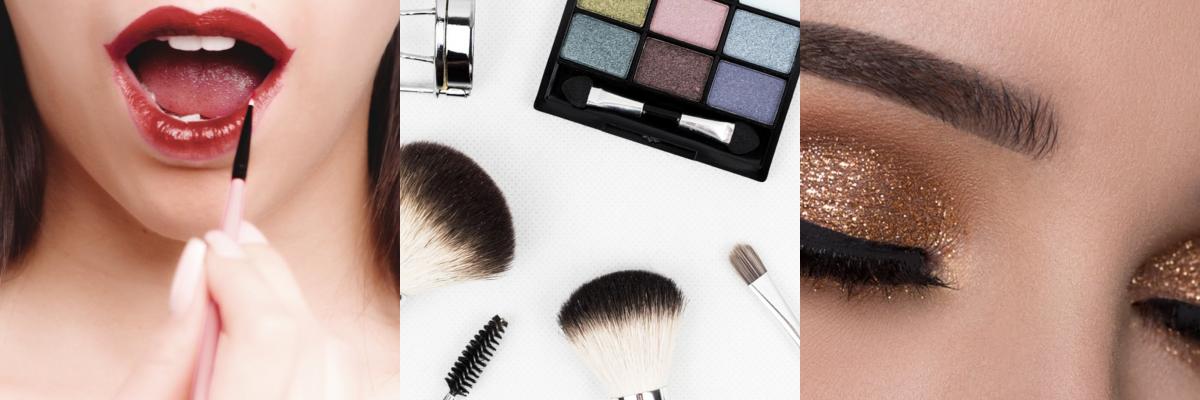The holidays are always busy with family get-togethers and holiday parties, and a lot of people have at least one or two occasions when they need to get dolled up over the course of the season. Just because you're blind or partially sighted doesn't mean you can't join in on the fun.
Makeup is something that can be intimidating to some folks who are blind or have sight loss – but it doesn't have to be! By using a few simple tips and tricks, anyone can build their makeup application skills, whether they have sight or not.
Getting started
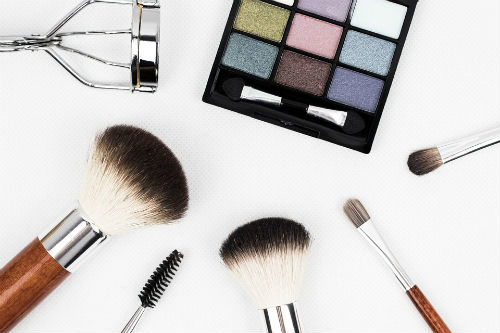 If you don't own any makeup, your first step will be to buy some of course. Start with a few basic products, like a foundation or powder, a lipstick, a mascara and a small eye shadow palette. You'll probably want to get some makeup remover wipes at this stage too. That way, if you make a mistake applying your makeup, you can always wipe it off and start over.
If you don't own any makeup, your first step will be to buy some of course. Start with a few basic products, like a foundation or powder, a lipstick, a mascara and a small eye shadow palette. You'll probably want to get some makeup remover wipes at this stage too. That way, if you make a mistake applying your makeup, you can always wipe it off and start over.
When you go to the makeup counter, it's a good idea to bring a friend with you to help you pick colours that work well for you. You can also ask the makeup sales clerk to help you. (Don't be shy – that's what they're there for!) Start subtle at this stage. Choose lighter, more natural colours that will be more forgiving if you make a mistake. Then when you get more confident, you can try more daring colours.
After you've purchased your products and brought them home, it's a good idea to mark them right away so you remember which product is which. This will become more necessary the more makeup you buy because similar products tend to feel the same way in your hand. You can use braille labels, bump-on dots or any other tactile marker that works for you. You can even wrap different numbers of elastic bands around your products for a cheaper solution.
Applying makeup like a pro
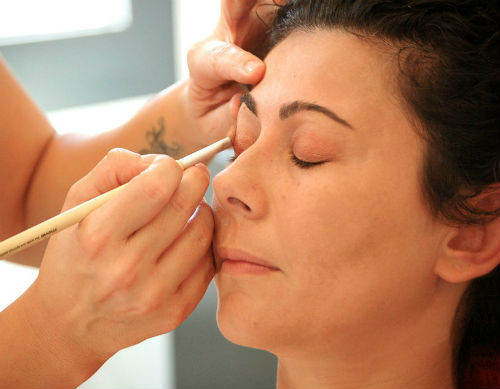 Okay, now that you've bought and labelled your products, it's time for the fun part: applying your makeup. Like anything else, practice makes perfect. Don't be discouraged if you have trouble at first – you'll get better at it with time.
Okay, now that you've bought and labelled your products, it's time for the fun part: applying your makeup. Like anything else, practice makes perfect. Don't be discouraged if you have trouble at first – you'll get better at it with time.
It's a good idea to plan a "makeup night" with a trusted friend if you've never applied makeup before. Make it fun – order a pizza, throw on your favourite music and maybe even bust out a bottle of wine (although not too much – you'll need a steady hand after all!). Then, have your friend do your makeup for you, telling you at each step what he or she is doing so you can get a sense of how it feels. Then you can remove the makeup using your makeup remover wipes, and try it yourself.
Now that it's your turn to apply the makeup, your friend can tell you how you're doing and help guide you as you go. Ask them, "What does this look like? Is it too heavy? Too light?" When you're done, remove the makeup again and do the whole process over. Again, practice makes perfect. And for people with sight loss, applying makeup confidently is often about repetition and muscle memory. So try, try and try again.
Feature-by-feature tips…
Face:
 There are lots of products you can use to make your skin look flawless, including concealers, primers, highlighters and contour palettes, but it's a good idea to start simple with a foundation and loose powder. These two products are great to use in combination (i.e., start by blending a thin layer of foundation all over your face, then set it with powder), but if you're not ready to try a foundation, you can start by using a powder alone.
There are lots of products you can use to make your skin look flawless, including concealers, primers, highlighters and contour palettes, but it's a good idea to start simple with a foundation and loose powder. These two products are great to use in combination (i.e., start by blending a thin layer of foundation all over your face, then set it with powder), but if you're not ready to try a foundation, you can start by using a powder alone.
- If you're using a foundation, make sure to blend it thoroughly so there's no streaking or harsh lines on your face. Some people who are blind prefer to use their fingers to blend foundation in because it helps to feel the product on the face, but others recommend using a blending sponge or blending brush to do this. Either way, just make sure to do a good, thorough job – and don't forget to blend the area where your face meets your neck so it doesn't look like you're wearing a mask.
- Blush is an easy way to brighten up your face. It's also pretty forgiving if you're not a makeup pro – just don't use a blush that's too dark. When applying blush, one of the biggest mistakes people make is that they use a small brush to apply it (usually the one provided inside the blush palette), and that can create a harsh line across the cheek. Instead, invest in a softer, bulkier brush so that the blush goes on more smoothly and looks more natural. You don't need to spend a lot. But even a brush that's $5 or $6 will be well worth the investment in the long run.
Eyebrows:
If you're going to use an eyebrow pencil, keeping your brows neatly shaped will make it a lot easier to fill them in properly, so consider having them waxed or threaded every so often. You can also pluck away those stray hairs if you feel confident doing so.
- Using an eyebrow stencil will help you get that perfect shape when filling in your brows with a pencil.
- When colouring with an eyebrow pencil, use a light touch and gradually build up the colour. Make sure to use the pencil evenly across your entire brow to avoid a patchy result.
Eyes:
 We don't realize it, but there are a lot of oils on our eyelids and that can cause your eye makeup to smudge and clump over the course of the day. You can also end up with eyeliner across the upper part of your lids, just from this oil. Of course, if you're blind or partially sighted, you won't be able to tell if this happens. That's why it's a good idea to prep your eyelids with a dab of loose powder before applying your eye makeup. It'll keep your lids from becoming oily and keep your makeup perfectly in place.
We don't realize it, but there are a lot of oils on our eyelids and that can cause your eye makeup to smudge and clump over the course of the day. You can also end up with eyeliner across the upper part of your lids, just from this oil. Of course, if you're blind or partially sighted, you won't be able to tell if this happens. That's why it's a good idea to prep your eyelids with a dab of loose powder before applying your eye makeup. It'll keep your lids from becoming oily and keep your makeup perfectly in place.
- Applying your eyeshadow will be much easier if you use an eyeshadow brush, and not the padded applicator that comes in the palette. To apply the shadow, just pretend you're painting your entire lid, and gradually decrease the pressure as you come to just above the crease of your eye. This will make for a softer transition to your skin colour. After you've applied the shadow, clean the brush to remove the colour you just used, and go over it again to blend it in. Like most parts of doing makeup, the trick to eyeshadow is blending thoroughly.
- If you want to try your hand at eyeliner, avoid using liquid liner or eyeliner pencils (at least if you're new to makeup) because they can be tough to perfect if you're blind or have low vision. Instead, try a pump-up liner like this one so that you never have to sharpen it, and it glides on smoothly without the potential mess of a liquid liner. You might want to start with a lighter colour, like a charcoal or brown, instead of black because it'll be a bit more forgiving. It's also good idea to do your eyeliner after your eyeshadow so that you don’t cover the eyeliner with the shadow.
When applying your eyeliner, close your eye or try to look downwards. Then, using your non-dominant hand, pull your eyelid taut to make it easier to glide the liner on smoothly. (Do this by placing a finger right beside the outer edge of your eye, and then gently pull back towards your ear.) Hold the eyeliner pen horizontally along the lash line – this way you'll get as close to the lash line as possible and it’s easier to glide the eyeliner along the lid. Begin with the pen held at the outer edge of your eye. Then gently pull the liner pencil across the lash line, making your way towards your tear duct. But don't take the liner all the way to the tear duct. You want to accentuate the outer corners of your eyes – not the inner corners. So as you glide the liner across your lash line, you'll want to slowly reduce pressure so that your liner gradually fades out towards the inner part of the lid, without having a harsh stopping point. (Note: Eyeliner is one of the tougher things to master when doing makeup, even for people who are sighted. It might be a good idea to practice this technique with a sighted friend watching. But don't get discouraged if you have a hard time with it at first – everybody does!)
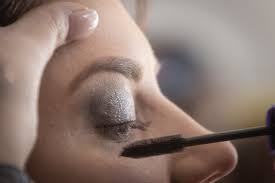 When applying mascara, it's a good idea to place a bit of Kleenex just below your eyes before you apply. This way, you'll avoid getting any mascara on your cheeks. Open your eye as wide as you can (many people find it helps to open their mouth at the same time) then glide the mascara from the base of your top lashes all the way to the ends. You'll probably need to do that two or three times to cover your lashes all the way from the tear duct to the outer edge. Some people also add a couple of touches of mascara to their bottom lashes, but that's up to you.
When applying mascara, it's a good idea to place a bit of Kleenex just below your eyes before you apply. This way, you'll avoid getting any mascara on your cheeks. Open your eye as wide as you can (many people find it helps to open their mouth at the same time) then glide the mascara from the base of your top lashes all the way to the ends. You'll probably need to do that two or three times to cover your lashes all the way from the tear duct to the outer edge. Some people also add a couple of touches of mascara to their bottom lashes, but that's up to you.
Lips:
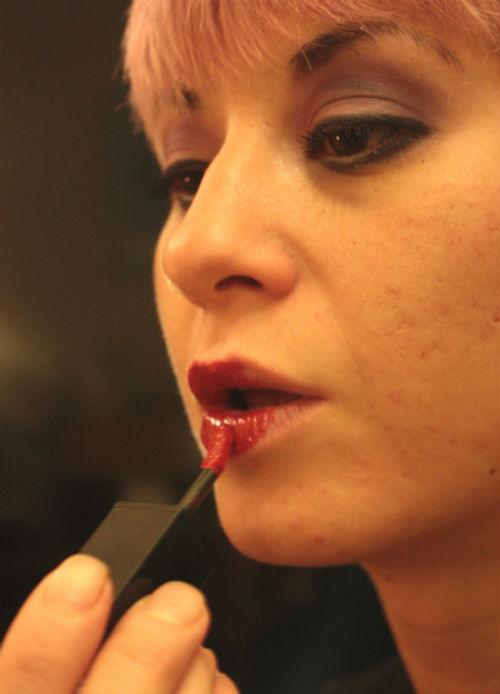 If you're not ready to try lipstick just yet, start with a coloured lip gloss. This way you get some lovely colour on your lips, without worrying about applying it perfectly within your lip line.
If you're not ready to try lipstick just yet, start with a coloured lip gloss. This way you get some lovely colour on your lips, without worrying about applying it perfectly within your lip line.
- Another thing about lip line? It's not the end of the world if you go outside it a bit. Many women purposely apply their lipstick a touch outside their lip line to make their lips look bigger. So if you don't colour quite inside the lines, don't worry about it too much. Just try to make it even all around.
- A good way to make sure your lip colour is evenly distributed is to gently press your lips together after applying it.
- After you've applied your lipstick, place your pointer finger in your mouth and wrap your lips around it gently, then release your finger. This will help remove any excess lipstick and, more importantly, make sure you don't get it on your teeth.
So go on, get glamorous and try your hand at makeup! But remember, makeup is supposed to be fun – and it's all about feeling good about yourself. So if it's not fun and it doesn’t make you feel good, don't keep doing it! Besides, you're beautiful just the way you are.
